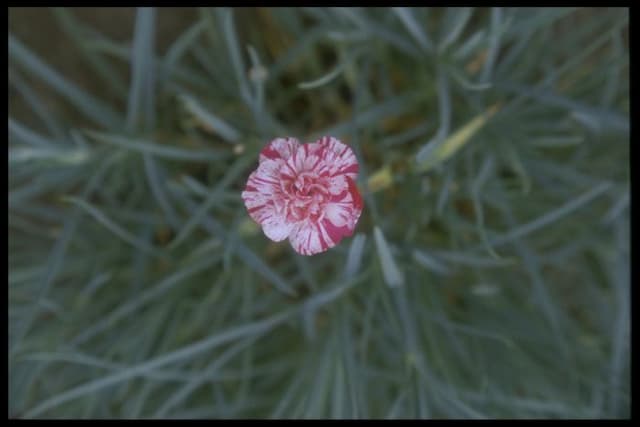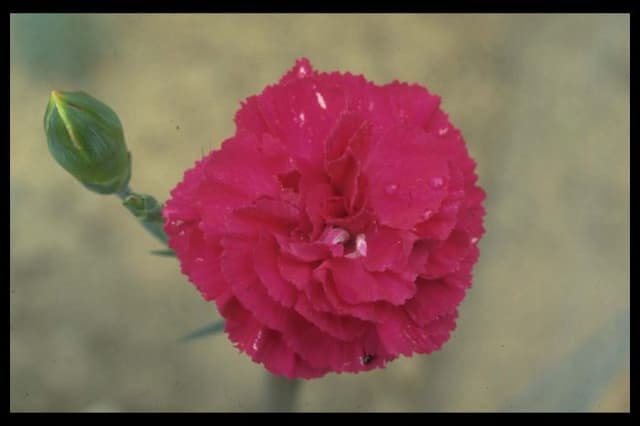Rose of Heaven Silene coeli-rosa

ABOUT
The plant commonly known as Rose of Heaven boasts a remarkable display of dainty blossoms that captivate the eye. These delicate flowers exhibit a hue reminiscent of the twilight sky, often in vibrant shades of pink or soft blush, with the occasional appearance in pure, striking white. Each flower typically comprises five petals that exhibit a charmingly fringed or ragged edge, adding a touch of whimsy to their overall form. The petals surround a contrasting center, drawing pollinators into their sweet embrace. The foliage of the Rose of Heaven provides a lush backdrop for its celestial blooms. The leaves show a green palette that can vary in intensity, seamlessly blending into many garden settings. Their shape is slender and elongated, often with a slightly sticky surface that hints at the plant's resilience. Together, the floral display and the verdant leaves create a tapestry that evokes the wild beauty of untamed meadows. The plant's growth habit is such that it forms graceful mounds or clumps, with the flowers perched atop slender, strong stems that dance in the breeze. It possesses an inherent elegance that makes it a favorite among gardeners looking to add a splash of color without overwhelming their garden space. The overall appearance of the Rose of Heaven is one of delicate beauty that, despite its ethereal look, is rooted in a sturdy, robust nature.
About this plant
 Names
NamesFamily
Caryophyllaceae.
Synonyms
Rose of Heaven, Viscaria.
Common names
Silene coeli-rosa.
 Toxicity
ToxicityTo humans
The plant commonly known as Rose of Heaven (Silene coeli-rosa) is not typically recognized for being toxic to humans. There are no well-documented cases or significant concerns regarding toxicity upon ingesting this plant. However, like with any plant material, individual sensitivities or allergic reactions could occur and it is generally advisable to avoid ingesting plants that are not known to be edible.
To pets
Rose of Heaven (Silene coeli-rosa) is also not known to be toxic to pets, such as cats and dogs. There is no widespread evidence of toxicity in pets upon ingestion of this plant. That being said, monitoring your pets and preventing them from eating plants, especially in large quantities, is still a prudent measure to avoid potential digestive upset or unexpected allergic reactions.
 Characteristics
CharacteristicsLife cycle
Annuals
Foliage type
Deciduous
Color of leaves
Green
Flower color
Pink
Height
1 feet (30 cm)
Spread
1 feet (30 cm)
Plant type
Herb
Hardiness zones
9
Native area
Mediterranean
Benefits
 General Benefits
General Benefits- Ornamental value: The blue-petaled flowers of blue catchfly add aesthetic appeal to gardens and landscapes.
- Attracts pollinators: Blue catchfly can attract bees and butterflies, which are essential for pollination.
- Drought resistance: Adapted to survive in dry conditions, requiring less water than many other garden plants.
- Low maintenance: Generally requires minimal care once established, making it suitable for gardeners of all skill levels.
- Soil erosion control: The plant's root system helps stabilize soil and prevent erosion.
- Adaptability: Capable of growing in a variety of soil types, from sandy to loamy to clay soils.
- Ground cover: Can be used as a ground cover to suppress weeds and cover bare spots in the garden.
 Medical Properties
Medical PropertiesThis plant is not used for medical purposes.
 Air-purifying Qualities
Air-purifying QualitiesThis plant is not specifically known for air purifying qualities.
 Other Uses
Other Uses- Catchfly, due to its sticky stems, can be used as a natural flytrap in gardens to reduce the number of small insects.
- The vibrant flowers of catchfly make it an ideal candidate for nocturnal pollinator gardens, attracting moths and night-flying bees.
- Catchfly can be used in educational settings to study the adaption of plants in attracting pollinators through its sticky surfaces and nocturnal blooming.
- The sticky sap of catchfly has been utilized in traditional children's games as a natural, biodegradable sticky substance for crafting and play.
- Gardeners might use catchfly as a companion plant to deter pests from more valuable plants in the garden.
- Due to its texture, catchfly can be incorporated into sensory gardens, which are designed to provide tactile experiences.
- With its eye-catching visibility at night, catchfly is suitable for moon gardens, which are landscapes designed to be enjoyed in the evening.
- The dried flowers of catchfly can be used in potpourri mixtures to add color and a light, pleasant fragrance to a room.
- Catchfly's vibrant petals can be used as a natural dye for fabrics and papers, offering an eco-friendly alternative to synthetic dyes.
- In artistic fields, catchfly is sometimes used as a subject for botanical illustration, teaching artists about plant structure and color.
Interesting Facts
 Feng Shui
Feng ShuiThe Rose of Heaven is not used in Feng Shui practice.
 Zodiac Sign Compitability
Zodiac Sign CompitabilityThe Rose of Heaven is not used in astrology practice.
 Plant Symbolism
Plant Symbolism- Divine Love: The common name of Silene coeli-rosa, "Rose of Heaven," suggests a link to the divine and celestial love due to its heavenly connotation.
- Purity: "Rose" often symbolizes purity, and when combined with the heavenly aspect, it emphasizes an incorruptible and spiritual innocence.
- Beauty: Roses are traditionally associated with beauty, and this applies to Silene coeli-rosa as well, indicating an otherworldly or spiritual form of beauty.
- Transcendence: As a plant with "Heaven" in its name, it can symbolize the notion of transcending the earthly plane towards a higher existence.
- Hope: The skyward direction of the flowers can symbolize hope and aspiration, as they seemingly reach towards the celestial realm.
 Water
WaterThe Rose of Heaven, commonly known as Silene coeli-rosa, prefers evenly moist soil, so it should be watered when the top inch of soil feels dry to the touch. Typically, this means watering it once a week, but frequency may vary depending on environmental conditions like heat and humidity. The method of watering should be gentle, avoiding direct water on the foliage to prevent fungal diseases. Aim to water the base of the plant, and provide approximately 1 gallon of water each time for a medium-sized plant to ensure the root zone is thoroughly moistened.
 Light
LightThe Rose of Heaven thrives in full sun conditions, which means it should receive at least six to eight hours of direct sunlight each day. The best spot for the Rose of Heaven would be a south-facing garden bed or a location where sunlight is abundant throughout the day. However, in extremely hot climates, some afternoon shade could be beneficial to prevent scorching.
 Temperature
TemperatureThe Rose of Heaven prefers a temperate range and can survive in minimum temperatures of about 40 degrees Fahrenheit to a maximum of around 85 degrees Fahrenheit. The ideal temperature for the Rose of Heaven is between 60 and 75 degrees Fahrenheit. It's important to protect it from frost, as well as excessive heat, which may necessitate provision of some shade or mulch during the hottest parts of the year.
 Pruning
PruningThe Rose of Heaven benefits from pruning to remove dead or faded flowers, which encourages further blooming and maintains the plant's attractive appearance. Pruning can be done as needed throughout the blooming season. The best time to prune for shaping the plant is during late winter or early spring before new growth begins, which helps to promote a bushier growth habit.
 Cleaning
CleaningAs needed
 Soil
SoilRose Campion (Silene coeli-rosa) thrives in well-draining soil with a neutral to slightly alkaline pH, between 6.0 and 7.5. A good soil mix for Rose Campion can be prepared by combining two parts garden soil, one part coarse sand or perlite, and one part compost to ensure good drainage and fertility.
 Repotting
RepottingRose Campion should be repotted every two to three years as the plant can outgrow its container. Repot in late winter or early spring before new growth begins, using the soil mix as mentioned above.
 Humidity & Misting
Humidity & MistingRose Campion prefers average to low humidity levels and does well in the humidity typically found in most home environments. Excessive humidity can lead to fungal diseases, so it is best to maintain good air circulation around the plant.
 Suitable locations
Suitable locationsIndoor
Grow Rose Campion in bright light; allow soil to dry between watering.
Outdoor
Plant Rose Campion in full sun; well-drained soil; water when dry.
Hardiness zone
4-8 USDA
 Life cycle
Life cycleSilene coeli-rosa, known as rose-of-heaven, begins its life cycle when the seeds germinate in the spring, thriving in well-draining soil with full sun exposure. The seedlings emerge and develop a rosette of leaves at the ground level before sending up flowering stalks. The plant flowers in late spring to early summer, producing white to pale pink blooms that open during the evening and are often fragrant. After pollination, which is primarily by nocturnal insects, the plant produces a capsule-like fruit containing numerous small seeds. The fruit matures and the seeds are dispersed by wind or gravity in late summer to fall. Rose-of-heaven is an annual plant and completes its entire life cycle within one growing season, dying after seed production, with new plants growing from the seeds the following spring.
 Propogation
PropogationPropogation time
Spring to early summer
Propogation: The most popular method of propagating Silene coeli-rosa, commonly known as Rose of Heaven, is by seed. Seed propagation is typically done in the spring after the danger of frost has passed. To start, select a well-draining soil mix and sow the seeds thinly on the surface, as they need light to germinate. The soil should be kept moist but not waterlogged. Rose of Heaven seeds generally germinate within two to three weeks at a temperature of around 68 to 72 degrees Fahrenheit (20 to 22 degrees Celsius). Once seedlings have established and are large enough to handle, they can be transplanted to their final growing location, ensuring they are spaced adequately to allow for mature growth.






![Pink [Coconut Sundae]](/_next/image?url=https%3A%2F%2Fplants-admin.emdemapps.com%2Fimages%2Fplants%2F%2Fimages%2F604b5d09d4fd1.png&w=640&q=75)


